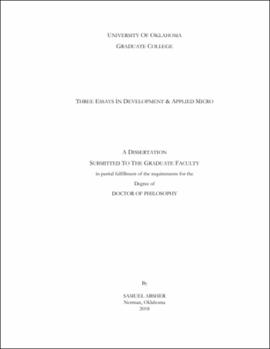| dc.description.abstract | Chapter 1: We explore what effect horizontal communication technologies, like mobile phones and the internet, had on levels of violence in the 2011 Libyan Civil War. We exploit a quasi-experiment within the civil war, where after Libya’s dictator, Muammar Gaddafi, severed telecommunication access in the eastern regions of Libya, the rebels were able to create their own network through a combination of ingenuity and luck. Using difference-in-differences and relying on the exogenous reactivation for identification, we estimate that the 32-day blackout treatment created an additional 116 conflicts in the affected districts. We add controls and estimate a treatment effect with a negative binomial estimator, finding that the blackout multiplied the number of expected per-day conflicts by a factor between 1.87 and 3.10. We find that both state initiated and rebel initiated conflicts increase during the blackout. We offer a novel explanation of the rebel response arguing that protestors may view internet activism and physical protests as substitutes. When Gaddafi removed access to internet and mobile phone technology, he may have funneled political dissent from digital to physical outlets.
Chapter 2: Latin American politics has long contained a Populist, Anti-Capitalist, perhaps we could call it Socialist strain. Despite the controversy surrounding the true effects of such regimes, little to no research has attempted a quantitative analysis of this “Socialist strain”. In this article, we use the synthetic control method to create valid counterfactuals for Bolivia, Ecuador, Nicaragua, and Venezuela and assess their performance relative to their counterfactuals along income, infant mortality, and inequality. The multi-event analysis, which calculates the average effect for these four cases, estimates a significant, both economically and politically, negative effect upon income. We observe a small, statistically significant increase in infant mortality. The treated average is not statistically dissimilar from the counterfactual in the analysis of inequality. At the single-country level, we find heterogeneity in the results. We propose that expropriation and nationalization drive the negative income effects.
Chapter 3: In this article, I use the geographic regression discontinuity framework to test the effect of Soviet occupation during WW2 in East Germany and measure its effect on modern day voting preferences for the Communist party. I find that the occupation, which involved widespread and severe civilian violence, created lasting, intergenerational dissent among the affected regions. Districts that experienced the brunt of the Red Army’s war atrocities observe a significantly decreased vote share for Germany’s Communist party, Die Linke, by approximately 3%. | en_US |
